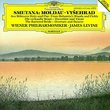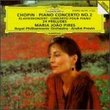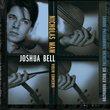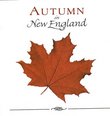| All Artists: Johann Sebastian Bach, Nikolaus Harnoncourt, Concentus Musicus Wien, Viennensis Chorus, Emiko Iiyama, Rotraud Hansmann, Kurt Equiluz Title: J.S. Bach: Mass in B minor Members Wishing: 0 Total Copies: 0 Label: Warner Music France Release Date: 8/16/2005 Album Type: Import Genre: Classical Styles: Opera & Classical Vocal, Historical Periods, Baroque (c.1600-1750) Number of Discs: 2 SwapaCD Credits: 2 UPC: 745099551728 |
Search - Johann Sebastian Bach, Nikolaus Harnoncourt, Concentus Musicus Wien :: J.S. Bach: Mass in B minor
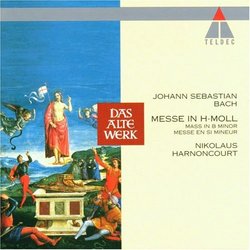 | Johann Sebastian Bach, Nikolaus Harnoncourt, Concentus Musicus Wien J.S. Bach: Mass in B minor Genre: Classical
|
Larger Image |
CD DetailsSimilarly Requested CDs
|
CD ReviewsA recording which changed Bach performance for ever Peter G. Watchorn | Cambridge, MA USA | 06/20/2002 (5 out of 5 stars) "This was the recording which changed for ever the way we thought (and continue to think) about Bach performance. Since it is now but one of many "period instrument" performances, it is easy to lose sight of the overwhelming effect which this recording had on those hearing it for the first time in 1968 (I was one of the fortunate first to experience the overwhelming power of Bach's masterpiece revealed in this performance at the tender age of 11!). Many of the details which contributed towards making the original recording uniquely important have now been omitted in the documentation accompanying this re-issue (a far cry from the lavish booklet of the original LP release of 1968). First, although Harnoncourt is credited as conductor, the performance was actually directed by Hans Gillesberger, perhaps the most important of the directors of the post-war Vienna Boys' Choir. Harnoncourt led the Concentus Musicus Wien from the cello (as he did for many of the Bach choral recordings made for Telefunken in the '60's and '70's). Perhaps equally important, this recording was the brain-child of the great German producer for Telefunken, Wolf Erichson, whose SEON and later, Sony Vivarte recordings have continued to document the most important "period-instrument" performances to the present day. Among the vocal soloists were such great singers as Rotraud Hansmann (unjustly neglected by recording companies in later years), the wonderful Helen Watts (who also recorded the B-minor mass with Karl Munchinger and Johannes Somary), the exemplary Kurt Equiluz, still the greatest Bach tenor of our time, and the superlative Max van Egmond, whose standards have not (and probably will not) ever been surpassed (listen to the "Et in Spiritum sanctum" and you'll agree). Add to this the almost viscerally thrilling sound of the Viennese trebles, and you have one of the greatest (and most influential) recordings of all time. Also lost on this re-issue is the important detail that Harnoncourt used three different sized choirs for this recording (small: 16; medium: 24; large: 42). He matched the size of the accompanying instrumental forces to suit. Numerous other details added up to what was for its time a uniquely thorough attempt to do justice to Bach's transcendental work. It's true that there have been advances in period performance techniques in the 34 years since this recording appeared, but to hear this recording is to experience the B minor mass with the excitement of discovery. Just try the transition from the bass solo "Quoniam" to the "Cum sancto spiritu", and the "Confiteor" into the "Et expecto", and you'll see why this recording deserves to be considered one of the great performances of the 20th century, as much a tribute to the largely forgotten Hans Gillesberger as it is to Harnoncourt, without doubt one of the great interpreters of our time. Buy it! It still sounds truly amazing." First period time B-minor Mass is still greatly competitive Mr JB | Karlskrona Sweden | 06/04/2001 (4 out of 5 stars) "Here we have Nicolaus Harnoncourts first recording of Bach's great Mass i b-minor, made in 1968. What's highly notable is that it's done with a small choir and orchestra, on period time instruments - making it one of the very first such recordings, that are so popular today. Fortunately the orchestra doesn't at all sound as annoyingly direct and obtrusive as with some more recent recordings - and that is a compliment to Mr Harnoncourt and his players. It also uses boys (the Wiener Sängerknaben) singing the choir's soprano and alto parts, making the upper register clean and transparent, although the solos are taken by women. So, the virtuosity somewhat lost by using boys is far compensated by more transparent textures.The result is a light and airy performance, that still captures the many dynamic possibilities in this great music. It actually seems that smaller ensemble makes for wider dynamics, not lesser. The opening Kyrie, for example, strikes you with both power and good timing in the choir - how often are those well combined? In the middle of the following 'Gloria' the work calms down, making you almost jump out of your chair when the playfull final 'Cum sancto spiritu' starts. And the rest of the performance follows this pattern - light textures combined with great dynamics in the choir and the orchestra. The powerful 'Sanctus' is a great example of this - although massive and powerful, it is never blurry. The soloists then? Well, here it's not as easy to make a oneway praise. The alto, sung by Helen Watts, is great and stands out as the clearly best soloist - beautiful timbre and very clean sounding. The bass of van Egmond is also very well done - not sounding heavy or 'bumpy' as basses sometimes does, his performance is smooth both in higher and lower registers. The rest of the soloists sounds nice and neat, but somewhat unpersonal. The 1st soprano of Rotraud Hansmann, has a not wide, but somewhat penetrating vibrato. All together though the soloparts are nicely judged, especially in some of the duets. I can't find any greater drawbacks in this recording - it might lose some nerve in the more quiet parts, the Vienna boys are a little too audible especially compared to the basses and the soloists aren't an all through first rate line-up, but I think that's well compensated by the clear and transparent textures, and the obvious feeling of an ensemble that's heading towards the same goal. I bought this record since the church choir that I sing in was going to perform parts of this lovely mass. I went around among many record dealers and listened through about ten different versions, amongst them Gardiner's, Christopher's, Karajan's, Marriner's a.s.o. I preferred this 'cause I thought it to be the most natural sounding. No strange manners from any part of the ensemble. Not to be forgotten, it's also great value compared to many other popular versions. Recommended!" This is what bach intended R. Guth | 08/26/2005 (5 out of 5 stars) "The performance captured in this landmark recording is its own best argument for the "period instrument" approach, because Harnoncourt's scholarly accuracy is placed entirely at the service of rendering Bach's voice as clearly and as compellingly as possible.
Other reviewers here have noted the meticulous research on performance history that went into constructing the various choral groupings Harnoncourt used. As the CD notes DO tell us, Bach also had very definite thoughts on the size and balance of instrumental ensembles. He didn't write for our massive, glossy-sounding modern string sections... nor did he write for metal flutes and plastic oboes. Over and above the issue of ensemble size, the period instruments simply SOUND better for this music: their rich, quirky sonorities are ideally suited to the winding and intricate musical lines Bach wrote for them (go figure!). The B minor mass is a great human achievement, and this recording of it demonstrates why. I've played the closing "dona nobis pacem" for friends who thought Bach was "unemotional," and enjoyed just watching their eyes fill up (I love being right!). If I had to reduce my CD collection to a single album, this is unquestionably the one I would reach for. " |

 Track Listings (12) - Disc #1
Track Listings (12) - Disc #1